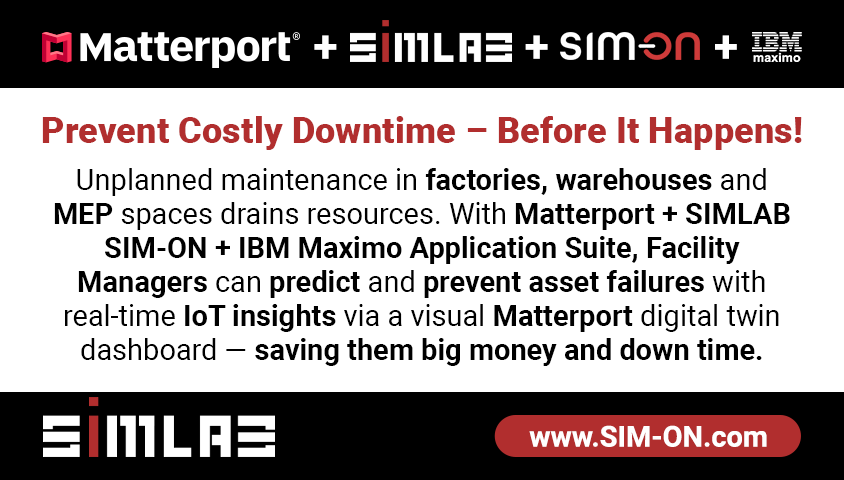Matterport Virtual Reality (VR) SDK Sign-up2998
Pages:
1
 WGAN Forum WGAN ForumFounder & WGAN-TV Podcast Host Atlanta, Georgia |
DanSmigrod private msg quote post Address this user | |
Video: How to Share a VR Space | Video courtesy of Matterport On this Matterport Virtual Reality (VR) page, Matterport announced that its VR SDK "is coming." Developer can sign up now "to be the first to know" ... "We're also seeking early access partners to work on apps that incorporate Matterport as part of their experience. If you have a great idea for a VR app, or an existing app that could benefit from integrated Matterport content, we'd love to hear about it." Presently, Matterport offers "lightweight ways to integrate VR into your apps now." Add a VR Button – "Add a 'View inVR' button next to relevant content, and instantly port your users into a Matterport VR experience. They'll automatically be taken to a Matterport app (or be prompted to download one). When they're done, they'll automatically return to your site or app." Create VR Collections – "You can create custom playlists of VR Spaces and share them with a single link. Make collections of Spaces you represent, such as properties in a certain neighborhood or suites at a certain price point, or simply share Spaces from our public gallery to enhance your existing content." |
||
| Post 1 • IP flag post | ||

Frisco, Texas |
Metroplex360 private msg quote post Address this user | |
| I am confused. VR SDK? What are they going to offer beyond embedding your tour in another app? | ||
| Post 2 • IP flag post | ||

Putten NLD |
DannyBasting private msg quote post Address this user | |
| I actually applied for this somewhere last week when I came across the announcent on their website. Just got a reaction in my mail box. Matterport VR (Matterport Support) Oct 24, 5:10 PM PDT Hello Danny, Thank you for your interest in the Matterport Virtual Reality Software Development Kit. At this time, the Matterport VR SDK is still in development and only available on an extremely limited basis as part of an initial pilot program. Please understand that we cannot accept all individuals or organizations into the Matterport VR SDK pilot program at this time. We are primarily interested in finding partners that will not only use our SDK, but also help us improve it by offering critical feedback and developing applications and experiences that expand what is currently possible in virtual reality. Projects that are simple re-skins or user interface reworks of our already existing Matterport VR app will most likely not be selected until after further development of our Matterport VR SDK has occurred. The Matterport VR SDK is being developed for use with the Unity Game Engine, and is currently focused on supporting development for Google Cardboard and Gear VR mobile platforms. Expert level knowledge of Unity is highly recommended, and experience with mobile app development is strongly recommended. We will review the information you have provided. If we feel you are a good candidate or have an interesting use case for the Matterport VR SDK, we will contact you with additional information. As we develop our VR SDK tools further we will periodically reevaluate applications. If you have any additional information you would like to provide, (for example: details about what you would like to build or why you feel you would make a great candidate for our pilot program) please respond to this e-mail. Any additional information will be added to your application. Due to the volume of interest in our Matterport VR SDK, we will not be able to reply to all applications. Similarly, we may be unable to answer questions regarding the status of your current application ---- I was thinking of sending them the link to my UE4 tread. Perhaps get access to it and see what it is all about. |
||
| Post 3 • IP flag post | ||

Frisco, Texas |
Metroplex360 private msg quote post Address this user | |
| ... whoah. That's a lot more than I expected. This is NOT for CoreVR obviously... this would lead me to suspect that Matterport are still working on automated conversion to their full VR solution... no reason to use Unity with panos... This is a massive can of worms! Now what I'm confused about is ... why a VR SDK? Why not just an SDK that has VR support? This is specific... is it for being able to embed Matterport Models into other apps without use of their interface? So .. potentially ... one could code a furniture planner for VR by building onto their model in a VR environment? That doesn't really make sense though, does it? That application of an SDK wouldn't be VR specific. Any thoughts? |
||
| Post 4 • IP flag post | ||

Putten NLD |
DannyBasting private msg quote post Address this user | |
| I couldn't tell you why they went for that name. I do know however that Epic integrated a VR editor mode inside Unreal Engine 4 a little while ago. All though it wouldn't work for me (as I create my own assets and switch between a lot of different applications during the day), I could see this being pretty awesome for a level- or interior designer (providing they have access to all the needed assets and such from the moment they start).They could have a real sense of scale while designing. On an other note, your "Unity with panorama's" comment got me thinking. It would be pretty amazing to integrate that kind of functionality inside my Unreal projects. Being able to switch between the "Before panorama's" and new 3D design. Should be pretty doable by creating a sphere, inverting it's normals and projecting the panorama texture on it. Then tracking the player locations and teleporting to the closest panorama-sphere on command. I'd have to gain access to the panorama's first though. Teach me your ways Metro! Haha. Aaarghh... There are far to little hours in a day! :P |
||
| Post 5 • IP flag post | ||
|
|
UserName private msg quote post Address this user | |
| I stumbled upon this page which shows all the VR related forum topics in one place -- complete with most recent activity date. I've also been seeing folks wanting to use Matterport models in different ways, such as in game design. That's what I've been trying to do with Unity too. @DannyBasting - that "inverting the normals on a sphere and projecting panos on it" is a great idea that many Unity folks use to create their own VR worlds in Gear VR and Cardboard apps. I still have a question about how feasible it is to get photo-realistic quality from a Matterport OBJ we've downloaded and imported into a 3D program. I've used SO Podium to render Sketchup models, but they still don't come up looking like reality even though it does a good job. Maybe someone here knows of a good renderer that might perfect a downloaded, refurbished Matterport model. I'm going to try some other rendering programs (indigo and maybe even UE4, but maybe it's impossible to recreate a Matterport OBJ Showcase model exactly, ie, make the images look as good as they do in a real Showcase model. My desire is to put on a Daydream/Gear VR/Microsoft/TMobile headset and manipulate a modified Matterport Showcase model the same way I'd interact with a real video game. . I'm looking forward to the Daydream controller since that looks like a major leap in user control in a VR world. Google partnered with Epic, the makers of Unreal, and this video shows the Daydream controller in action (starts around 27 seconds into the video near the center of the page). They created a short demo of someone interacting in a game prototype using the controller. I'd love to simply point a virtual laser pointer to move to a new location or manipulate an object. You could move around a Matterport model very quickly using a controller like that. And then there's Microsoft's new Windows 10 VR headset. They said a bit about Hololens and holograms as they relate to their new Headset, but I'm not sure how that will work. But at $299 with built-in sensors, Microsoft may capture a large share of the VR market when it comes out next year, especially if its sensors, like the Vive's, let you walk around using your legs. MS says we'll be able to draw a 3D object in the upcoming Paint program, share it as a VR object with a friend and view it in their VR headset. One problem with so many VR devices coming out may be the inability of one company's standard to become "the" standard. If consumers must choose between Gear VR, Microsoft, Google, Rift and all the other proprietary VR platforms, a company like Matterport would have to code for them all or lose a part of the market. More people may even buy the Rift now that it runs on a $499 PC. |
||
| Post 6 • IP flag post | ||

Putten NLD |
DannyBasting private msg quote post Address this user | |
Quote:Originally Posted by UserName You can forget about using the OBJ itself to create a realistic looking renderings. The geometry is just way to messy and low poly. It's created to be lightweight for web use, with blurry transitions and dollhouse view in Matterport spaces. You can however use point-cloud data to create your own clean geometry extremely fast if you have access to the right tools. That's what I did for the UE4 project. Normally it would take me a small workday to set up a 2 floor apartment like that. Got it to an acceptable/usable level in an hour or two using the scanned data. |
||
| Post 7 • IP flag post | ||
|
|
UserName private msg quote post Address this user | |
| Thanks. I did read some forum post where some considered increasing the number of scans to improve the model. It'll be interesting to see how quickly you can complete a project. | ||
| Post 8 • IP flag post | ||

|
VRealExperience private msg quote post Address this user | |
| A Virtual Reality early adopter's .02 Get ready people, this is just the beginning. Anyone who has had a VR experience will tell you it's amazing. Anyone who has been in VR for a while will tell you, OK, still amazing, but then ask how far can this go? What's next? It's how we as humans work! We want the next wave of excitement. VR is here, and it's here to stay. Matterport sits at the top of the podium for their solution, hands down IMO...and most agree. But the real winner in this marathon is going to be who can create the most immersive experience (Hence my name, because you are "experiencing" it, not viewing). When this really will take off is when someone, (will it be Matterport?) allows for the following: - Custom staging: Add furniture, wall art, etc...in a house to Virtually stage it. If done be an agent, it helps them sell. if done by end users, it allows them to see if they can make the space theirs - VR Hangouts: Think the "Club" mentality here. 3D Map a place - this gives you the ability to GO there. Add VR - that gives you the ability to BE there. Add the ability to have multiple people who can interact and see one another? Well, now you have a very excited target market of Clubs or other organizations who have and maintain members or regulars that can hang out, shoot pool, play darts, cards, etc....in the same place and atmosphere they normally would. This is a ways out yet, because it's not fully there even on the high end market of VR, but closer than most would imagine. 2 use cases off top of my head, but I came here to research becoming a standard member and this is distracting me |
||
| Post 9 • IP flag post | ||

|
VRealExperience private msg quote post Address this user | |
Quote:Originally Posted by Metroplex360 My guess is they are trying to extend and cross a bridge to a not too far adjacent market. If you follow the VR industry, it applies to everything. Right now it is adopted by mostly gaming, but Music videos, cinematics, etc, are quickly becoming a defacto as well. It wouldnt be too hard for Matterport to find themselves in a market for venues, or concert halls, where the property is accurately mapped with their existing solution, and with opening up an SDK to expert developers, allow for multiple people to gather and experience together, in a "real" virtual version of the venue. Just one scenario. In other words, I think you have to think out of the box of Matterport's traditional application for this one. |
||
| Post 10 • IP flag post | ||

|
VRealExperience private msg quote post Address this user | |
Quote:Originally Posted by UserName Owner of an HTC Vive here - Which is the premium on the market. The reason it is so far ahead of competition (though leveled as of recent with the rift) is the room-scale and positional tracking, in addition to motion controllers. You are IN it, also known as immersion. When you have "hands" and can move and it correlates seamlessly with the game, that is a whole new level of immersion. |
||
| Post 11 • IP flag post | ||
|
|
UserName private msg quote post Address this user | |
| @VRealExperience - I always wanted to at least test a Vive. I can't imagine what's it would be like to move around in a VR world. We'll have to see what Microsoft's $299 headset does next spring. It seems like they're saying that we won't need an Oculus, Vive or anything else because the Microsoft headset has all the sensors it needs built in. That would mean that we could move around, like in a Vive world, without needing any external cameras or sensors. That sounds too good to be true, especially for the price, but if it could do what a Vive does, Microsoft might take over the VR market since just about everybody has a Windows PC and many of them have Windows 10. A while back I posted a Microsoft video showing how Microsoft imagined a FUTURE where someone wearing a Hololens could share an experience with someone wearing a VR headset. I never imagined that Microsoft might be the one making the VR headset or that the future would be soon. Maybe it's next spring when they release the headset. If it's using the same scanning technology found in a Hololens, who knows what the AR and VR world might look like. Maybe Windows, Hololens and VR headsets would all work using the same Holographic platform making the real Windows 10 world merge with the AR world which merges with the VR world. Here's an article about yesterday's Microsoft event that unveiled Microsoft's revelations about its VR plans. It begins with, --- Microsoft Fires Shots At Rift And Vive, Calls Them ‘Less Immersive’ Than Partner Headsets -- "Microsoft had a big surprise for VR fans today, revealing a new range of VR headsets alongside its latest Windows 10 update. Not only are these devices cheaper than the Oculus Rift and Vive, but Microsoft says they’re better too. There’ll be zero need for a separate room, zero need for a complicated setup. And while those other less immersive accessories today cost over $500, most of the time requiring a new, expensive device, we’re announcing today that these Creators Update accessories will start at just $299.”" ----- It seems like there has to be a catch somewhere, especially with the $299 price. Maybe there are downsides like poorer image quality. But, $299 is less than a Google Pixel phone or a Samsung phone needed to run Gear VR and Daydream. So, I'm counting the days until next spring when they say we'll see what Microsoft's releasing. If Hololens can scan a room like a Matterport camera does, and Microsoft's VR headset using Holoens technology running on Windows 10, maybe their headset can function like a Vive. |
||
| Post 12 • IP flag post | ||

Frisco, Texas |
Metroplex360 private msg quote post Address this user | |
Quote:Originally Posted by DannyBasting Hey - is the point cloud data from Matterport actually pretty good? I had always assumed it was the same quality as the OBJ, just in a different format. This is VERY interesting if it's higher quality. |
||
| Post 13 • IP flag post | ||

Putten NLD |
DannyBasting private msg quote post Address this user | |
Quote:Originally Posted by Metroplex360 You can't compair those at all. The pointcloud data is way more accurate, but it's not polygon based. The OBJ file is probably batch generated from the cloud data. There is a free tool called Meshlab wich allows you to create meshes from pointclouds. But you need a CRAZY high-end computer to generate anything usefull. I assume Matterport uses something similar for their conversions. |
||
| Post 14 • IP flag post | ||

Putten NLD |
DannyBasting private msg quote post Address this user | |
Check out the difference between the 2 files below.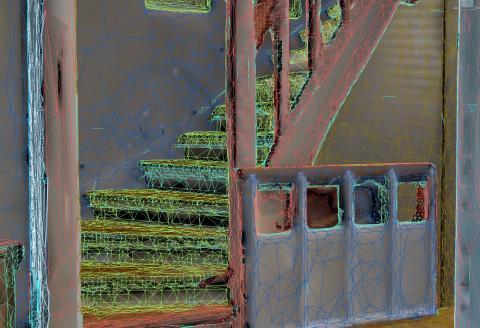 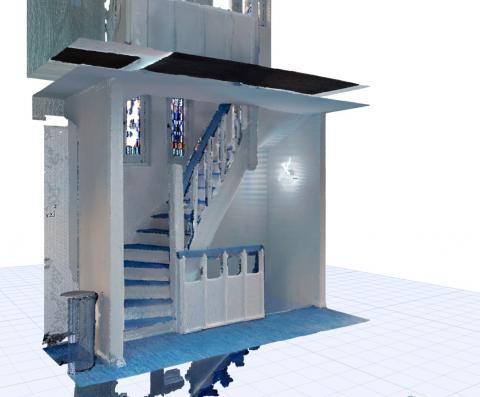 |
||
| Post 15 • IP flag post | ||

|
VRealExperience private msg quote post Address this user | |
Quote:Originally Posted by DannyBasting Do you need GPU/CPU performance? If so, is it something you could walk me through? I have a i7/GTX1080...top end CPU/GPU. If I can help you do something to validate let me know |
||
| Post 16 • IP flag post | ||

Putten NLD |
DannyBasting private msg quote post Address this user | |
| Yeah sure, no problem. I actually made a conversion myself after posting in this thread. Been a while since I used the software, and reading this topic made me think of it again. I have access to a more high-end computer then I did back in the day. Anyway's, I'd be happy to walk you through it. |
||
| Post 17 • IP flag post | ||

|
VRealExperience private msg quote post Address this user | |
Quote:Originally Posted by UserName TL : DR - If you dont care about the VR industry in general, skip to the last paragraph or two for my opinions with respect to these announcements and Matterport. Good stuff man, glad to see your interested. My VR interest materialized about 5 months ago, when I was keeping myself up at night thinking about the complexities of this society we live in shortly after being introduced (verbally via the Joe Rogan/Duncan Trussell podcast) and I began applying the potential practical applications to the world we live in, primarily education, science, and positive entertainment. Those thoughts became a mini mental addiction, and in communication with my wife she seemed receptive and here I am, somehow a MP pro? It was a bizarre sequence of events that I wont bore you with... Nonetheless, the Vive sets the bar for all the others, at least technologically. Though, content is still the issue for me. To your point, there are many angles and no standards. In an unsettled market, Developers are very scattered, because they share different views, have different skills, and until the market dictates where they all flock the end result is all over the place. Once the VR settled like consoles did (Xbox vs Playstation) it will become stabilized, for better or worse. The Microsoft one didnt really change much from my end. I have been hearing rumblings about 6DOF (6 degrees of freedom) and inside out tracking, I guess the only surprise is Microsoft was the one making the announcement. I expect the $299 to be a GearVR level quality + the expected relative advancement in basic technology components since GearVR until their release date and adding the 6DOF to justify the additional $230 to the GearVR. As you go upscale, more power in terms of graphics, likely better lens for graphics, more comfortable headstrap. The biggest takeaway from the announcement isnt even the headsets. The biggest announcement was Windows 10 update tagged "Creators" - Allowing for scanning in 3D, 3D Printing, and experiencing in 3D. It's not far until 3D Avatar characters are created by scanning yourself, likely using the same cameras as Xbox Kinect (which is also what the Matterport PRO uses). Find a cool game that allows you walk through the park...go ahead and 3D print a walking stick, or a steering wheel for a racing game. Crazy stuff. To conclude this, and tie back into Matterport - this could very well be what Matterport is up to with their SDK release. They are certainly up to some Hardware related things, which is everything but proven per Dan's tactfulness in finding recent job postings, but they are looking for developers too. If Matterport does NOT crack the code, to allow a 3D Scan we perform, to be virtually staged, or allow multiple users to attend and "immerse" and interact for Virtual Open Houses, speaking with a realtor virtually onsite of the prospective location, or having people hangout and play darts or pool at a Bar, then they will lose this war....because someone will surpass them, and quickly. |
||
| Post 18 • IP flag post | ||

|
VRealExperience private msg quote post Address this user | |
Quote:Originally Posted by DannyBasting Meh, I was just offering to help. I dont even understand the context and reasoning for what you were discussing LOLOLOL But, might as well ask - What was the difference between the two pictures in the first place? |
||
| Post 19 • IP flag post | ||

Putten NLD |
DannyBasting private msg quote post Address this user | |
| Haha okay.. I didnt quite get that. But thank you for offering your assistence! I'll try to explain the difference. A 3D model contains points located somewhere in a 3D space. A pointcloud (the second image) is a file containing ALOT of these points. If you where to open a pointcloud in a texteditor you can see it the coordinates of each point along with the RGB value of the point. Here are a just few lines from the pointcloud I used in my example: -5.073570 2.938401 2.786698 141 135 124 -5.073570 2.941165 2.791003 129 124 115 -5.075639 2.938401 2.791003 134 128 117 The first value in each line being the X-axis, the second Y, third Z. The other values being R G B respectively. The actual pointcloud contains allmost 5 million lines (so the exact same amount of points in 3d space). If you where to connect those points (refered to as vertices) with lines (edges), you can create 3d planes (faces). See image below. 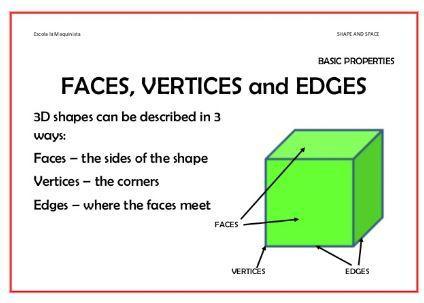 The OBJ file takes a small portion of the vertices from the pointcloud, and creates edges and faces in between them to create useable geomerty. |
||
| Post 20 • IP flag post | ||
|
|
UserName private msg quote post Address this user | |
| @DannyBasting - I tested a converted Matterport point cloud in Unity a long time ago. Things didn't work out too well. I might give it another try. Even with a model, I'm not sure we can move to any point in a model since the Matterport camera didn't capture all views from all possible coordinates in a room. Meaning I probably can't, like in a real video game, move 9 inches to the left to see what a table really looks like from that point or rise 8 feet into the air to look down on a living room. Unless someone invents a scanner that can capture every point in an x y z sphere, 3D modelers may always be in demand. I once read a forum post where someone asked if it's possible to bypass 3D model creation by photographing a room using a Matterport camera and creating a true 3D model from the point cloud. @VRealExperience - Sounds like you're looking for a Star Trek holodeck. Even when holographic projectors and VR contact lenses make it to market, we still won't have true virtual reality like this .. 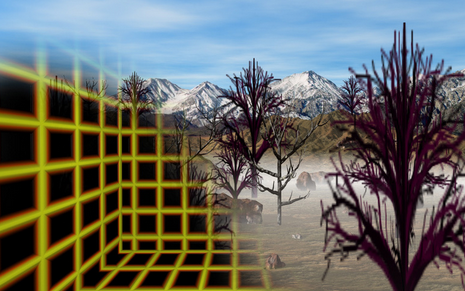 The Star Trek holodeck itself, on the left is actually quite small. Yet, multiple crew members inside it could see a world as big as they liked -- even entire cities. More importantly, they could hold virtual objects, taste virtual food and move in any direction as far as they liked. Lots of sites try to explain the science behind the holodeck. Small force field bubbles around a person, for instance, might give him the ability to walk around freely in the virtual world even though he never moves an inch in the actual holodeck. A realtor today could probably charge home buyers to come view his home listings if the realtor had a functioning holodeck. Unfortunately, all we have today are headsets that simulate reality. The real technology behind most VR experiences is actually simple. You see different parts of a panoramic image or video as you turn your head. They probably could have invented that decades ago if suitable hardware existed back then. Matterport and game designers come closer to VR by at least putting you inside a real 3D representation of reality -- a model. Maybe a Star Trek holodeck may never exist regardless of how much technology advances on this or any other planet in the next trillion years. Perhaps there's a limit to what is possible. The best I probably hope for is a pair of glasses that let me see virtual worlds. Treadmills may let me "walk" and touch controllers may simulate tactile interaction, but I'll probably never touch and throw a "real" baseball in a virtual baseball game that's indiscernible from a real one. Some may not have seen the amazing Hololens Holoportation video showing a man's daughter moving all around him. 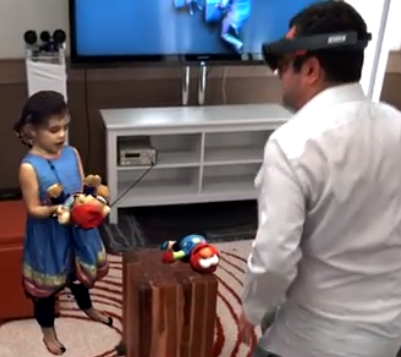 (his daughter appears in the video at the 2 minute mark) He wears a Hololens and his daughter, in another room is surrounded by special cameras. As she moves around, the cameras convert her into a hologram that's sent to her father's Hololens. Hence, he's able to experience her as if she's really there. Maybe Microsoft has future plans for those Holoportation cameras but the whole process probably costs a lot of money now since the Hololens by itself is 3K. But, I imagine that they haven't revealed all their plans which could involve attempts to bring everybody into their Windows 10 VR world where you can't hold real things, but you can at least see, hear and experience virtual people, objects and environments. |
||
| Post 21 • IP flag post | ||
Pages:
1This topic is archived. Start new topic?



